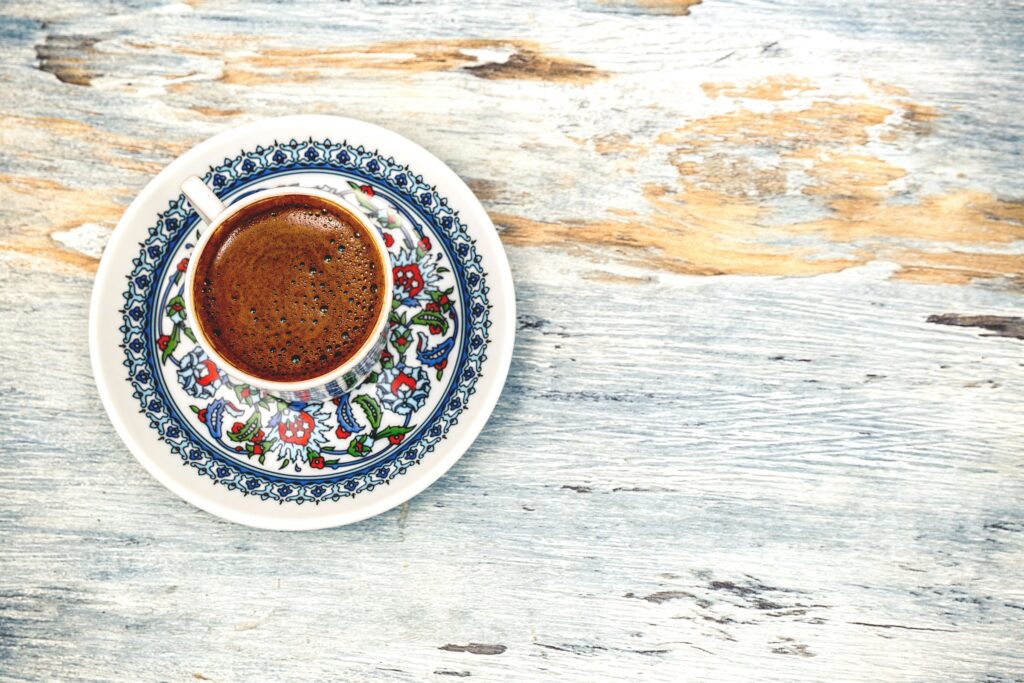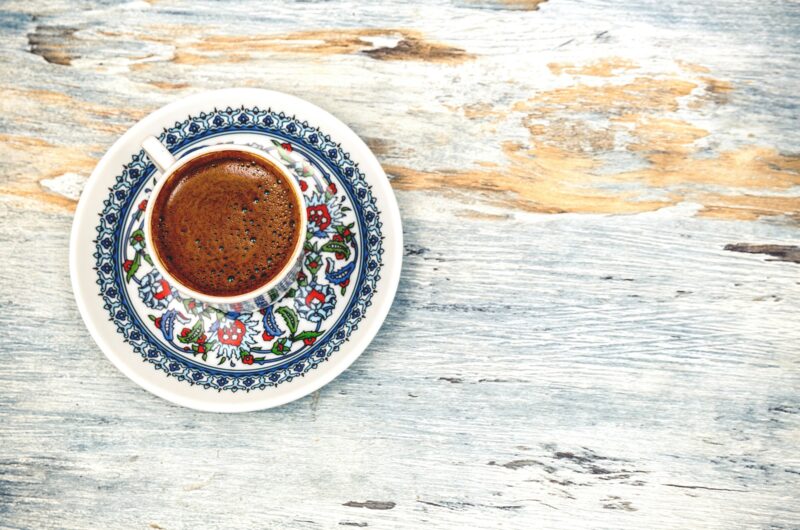Tiny cups. Thick, velvety coffee. A ritual that’s been practiced for centuries. Turkish coffee isn’t just a way to get your caffeine fix, but it’s a cultural experience poured straight into your cup.
Born in the heart of the Ottoman Empire, this method has traveled through time, carrying with it stories of hospitality, tradition, and a little bit of magic.
It’s coffee you don’t just drink—you savor, sip by sip, with every layer of foam and every grain of grounds.
In this post, you’ll learn where Turkish coffee comes from, how to prepare it at home, and why its flavor and rituals make it worth trying at least once in your life!
A Brief History of Turkish Coffee
Turkish coffee traces its roots back to the 16th-century Ottoman Empire, where it quickly became more than just a morning ritual, but it was woven into the fabric of daily life, from bustling markets to the quiet corners of grand palaces.
Coffeehouses sprang up across Istanbul, serving as lively hubs where merchants struck deals, poets recited verses, and everyday people gathered to swap news long before newspapers were a thing.
Offering a guest a small cup wasn’t just polite; it was a symbol of hospitality, a gesture that said, “You are welcome here.”
Over the centuries, this tradition spread beyond Turkey’s borders, influencing cultures across the Middle East, the Balkans, and North Africa.
The practice became so culturally significant that in 2013, UNESCO added Turkish coffee to its list of “Intangible Cultural Heritage,” recognizing not only the drink itself but the centuries of rituals, conversations, and connections it inspired.
Today, when you sip Turkish coffee, you’re not just tasting bold, rich flavors, but you’re sharing in a piece of living history that continues to bring people together around the world.
What Makes Turkish Coffee Unique
Extra-Fine Grind—Almost Powder-Like
Turkish coffee starts with beans ground so fine they feel like soft flour between your fingers. This isn’t your regular drip or espresso grind—it’s far finer, almost dust.
The reason is simple: the grounds aren’t filtered out. Instead, they stay in the cup, giving the coffee its signature texture and bold taste.
Without this ultra-fine grind, the drink wouldn’t achieve its smooth, rich body or that famous lingering finish.
No Filter: Coffee and Foam Served Together
Unlike most coffee methods that strain out the grounds, Turkish coffee embraces them. You pour everything—grounds, liquid, and foam—straight into the cup.
At first sip, you’ll notice it’s thicker, almost creamy, with a small layer of sediment settling at the bottom. That’s intentional.
In fact, leaving the last sip is part of the ritual, and those leftover grounds even get used for fortune-telling.
Brewing in a Cezve/Ibrik (Small Copper Pot)
The magic happens in a cezve, also known as an ibrik—a small, long-handled pot traditionally made of copper or brass. Its narrow neck helps form the perfect foam while keeping heat distribution even.
Brewing is slow and steady: you heat the water and coffee together over low heat, never rushing, and never letting it fully boil.
This method coaxes out deep flavors while creating that velvety texture people love.
Signature Foam Layer as the “Mark” of a Good Cup
The crowning glory of Turkish coffee is its foam. A thick, golden-brown layer forms as the coffee heats, and it’s carefully spooned into each cup before the liquid is poured.
This foam isn’t just for looks—it’s a sign of skill and patience. In Turkish culture, a cup without foam is like a handshake without eye contact: incomplete.
That silky top layer signals respect for tradition and care in preparation, making every sip feel special.
Tools and Ingredients You’ll Need
- Cezve/Ibrik
- A small, long-handled pot (traditionally copper or brass).
- Choose a size that matches your servings (e.g., a 6 oz cezve is perfect for 2 small cups).
- Coffee
- 1 heaping teaspoon (about 6–7 grams) of extra-fine ground coffee per serving.
- The grind should be powder-like, finer than espresso.
- Water
- About 2.5 oz (75 ml) of cold, filtered water per cup.
- Measure using the serving cup itself for accuracy.
- Optional Add-Ins
- Sugar:
- No sugar: sade
- A little sugar (½ tsp per cup): az şekerli
- Medium sugar (1 tsp per cup): orta şekerli
- Sweet (2 tsp per cup): şekerli
- Cardamom: 1–2 crushed pods or a pinch of ground cardamom.
- Other spices: cinnamon or cloves (just a pinch, optional).
- Sugar:
- Tiny Cups (Fincan)
- Small porcelain or ceramic cups, usually 2–3 oz capacity.
- Designed to highlight the foam and concentrate the flavors.
Step-by-Step Brewing Guide
Step 1: Measure Water into the Cezve
Start by filling your cup with cold, filtered water, then pour it into the cezve. This trick keeps your measurements precise with no guesswork needed. Each serving is about 2.5 oz (75 ml).
Always measure with the same cup you’ll be drinking from so the ratios stay perfect.
Step 2: Add Sugar and Spices Before Heating
If you’re adding sugar, cardamom, or other spices, this is the moment. Put them straight into the water before it even touches the heat.
Once brewing begins, you don’t stir again, so getting the sweetness and flavors balanced upfront is key.
Step 3: Stir in the Finely Ground Coffee
Add about one heaping teaspoon (6–7 grams) of that powder-fine coffee per cup. Give it a good stir so the coffee and water mix evenly.
At this point, your cezve looks more like muddy water than coffee—but patience will turn that “mud” into liquid gold.
Step 4: Heat Slowly, Never Boiling, Until Foam Rises
Place the cezve over low heat. This is where most people rush and ruin it. Turkish coffee needs time. As it warms, you’ll see a dark foam form on top.
Don’t let it boil because boiling destroys the delicate foam. When the foam begins to rise toward the rim, that’s your cue.
Step 5: Remove from Heat and Pour Carefully into Cups
Take the cezve off the heat just as the foam swells. Spoon a little foam into each cup first, then gently pour the rest of the coffee. This keeps the foam intact and divides it evenly.
Pouring too quickly will collapse the foam and stir up the grounds. Slow and steady wins the race here.
Step 6: Serve with Foam on Top
The final cup should have a rich layer of foam as its crown. In Turkish tradition, the foam shows care and skill. No foam? It’s like serving flat soda—it just feels wrong.
Set the tiny cups on a tray, usually with a glass of water and maybe a piece of Turkish delight. Now it’s not just coffee; it’s an experience!
Serving Rituals and Traditions
Serving Turkish coffee is as much about tradition as it is about taste, and every detail carries meaning.
A cup is almost always paired with a small glass of water to cleanse the palate before sipping, and in many homes or cafés it’s joined by a piece of Turkish delight for a sweet contrast to the strong brew.
Offering coffee to guests is an act of hospitality, and it often speaks louder than words—serving it with care shows respect and warmth, while refusing a cup can sometimes be seen as impolite.
In some regions, Turkish coffee even plays a role in marriage customs, where a bride-to-be prepares it for her future in-laws as a subtle test of her skill and patience.
Then there’s the playful tradition of fortune telling, where the empty cup is flipped upside down, the grounds left to settle into shapes that are “read” like a storybook of one’s future.
Flavor Profile: What to Expect
Drinking Turkish coffee is a full sensory experience, and the first thing you’ll notice is its strong, bold, and slightly gritty texture—because it’s unfiltered, the grounds settle at the bottom, giving it a thickness unlike drip or espresso.
The flavor itself is deep and earthy, often described as rich and full-bodied, with layers that shift depending on how it’s prepared; keep it plain and you’ll get a pure, almost smoky intensity, add cardamom and it turns aromatic and spicy, stir in sugar and it softens into a smoother, sweeter sip.
Unlike a quick shot of espresso you toss back in a hurry, Turkish coffee demands patience—it’s a drink meant to be savored slowly, letting the warmth and flavor linger while conversations stretch on.
In other words, it’s less about the jolt of caffeine and more about the ritual of slowing down, enjoying the moment, and letting every sip tell its own little story.
Health Benefits and Considerations
Turkish coffee isn’t just a cultural treasure—it comes with some health perks too.
Because the coffee is unfiltered, it’s packed with antioxidants, those handy compounds that help your body fight off cell damage and keep things running smoothly.
That said, it’s also a very concentrated brew, so moderation is key; a tiny cup delivers a bold punch, and drinking several back-to-back can leave you buzzing harder than a neon sign.
Traditionally, it’s enjoyed without milk, making it naturally dairy-free and a good fit for many diets, though some people do choose to add a splash of milk afterward for a softer taste.
Like most good things in life, it’s best when balanced—savor it slowly, enjoy the ritual, and let that little cup of liquid history do its job without overdoing it.
Tips for First-Time Brewers
Start with Plain (No Sugar) to Taste the Real Flavor
Your first cup of Turkish coffee is best tried plain. Skipping the sugar lets you experience its true character—bold, earthy, and slightly smoky.
Once you’ve tasted the original, you can experiment with sweetness levels or spices to find your own balance.
Think of it like meeting someone new; you want to know their real personality before adding any filters.
Use Freshly Ground Beans for Best Foam
The foam is the pride and joy of Turkish coffee, and fresh beans make all the difference. When beans are ground just before brewing, they release more oils, which help create that thick, creamy top layer.
Pre-ground coffee loses this magic quickly. If you want to impress, invest in a grinder that can handle an ultra-fine setting.
Patience: Slow Heating = Proper Foam
Turkish coffee is a slow dance, not a sprint. Keep the heat low and steady so the foam has time to form without boiling away. Rushing the process leads to flat, bitter coffee.
The reward for your patience is that signature golden-brown foam, which tells everyone you brewed it with care.
Don’t Stir After It Starts Heating
Once the cezve is on the stove and the coffee is mixed in, hands off the spoon. Stirring after this point breaks the foam and disturbs the grounds, leaving you with a muddy mess.
The trick is to let the coffee settle naturally as it heats. It may feel counterintuitive, but resisting the urge to fuss with it is what keeps your cup smooth and layered.
Final Words
Turkish coffee is more than just caffeine—it’s history, culture, and connection served in a tiny cup. Every sip carries a story, from the foam on top to the grounds at the bottom.
If you’ve never tried it, brewing at home is the best way to experience the magic for yourself. It’s simple, affordable, and a fun ritual to share with family or friends.
So grab a cezve, grind those beans, and give it a go.
And when you do, share your first Turkish coffee experience, you might just spark someone else’s journey into this centuries-old tradition!
FAQs
Can I use espresso beans for Turkish coffee?
Yes, you can use espresso beans, but the grind is what matters most. Turkish coffee requires an ultra-fine, powder-like grind that’s even finer than espresso.
Do I need a special grinder?
Ideally, yes. Most standard grinders can’t achieve the powdery texture needed.
A burr grinder with a Turkish setting or a specialty grinder works best. Some people even buy pre-ground Turkish coffee to make things easier.
How is Turkish coffee different from Greek coffee?
They’re nearly identical in method and taste, but the name changes depending on the region and cultural tradition. The cezve, foam, and unfiltered styles are the same.
Can you make it without sugar?
Absolutely. In fact, many people recommend trying it plain first to appreciate the bold, earthy flavor. Sugar is added only before brewing, so there’s no stirring it in afterward.
Is it safe to drink the grounds?
It’s not harmful, but most people stop sipping once they reach the thick layer of grounds at the bottom. They’re meant to be left behind or read for a bit of fortune-telling fun.
Turkish Coffee: A Traditional Method Worth Trying
Course: Brewing GuidesCuisine: Turkish / Middle EasternDifficulty: Easy2
cups2
minutes5
minutes7
minutesA traditional unfiltered coffee brewed in a cezve with a rich foam layer and bold, earthy flavor.
Ingredients
2 heaping teaspoons (12–14 g) extra-fine ground Turkish coffee
5 oz (150 ml) cold filtered water
Sugar to taste (optional: ½–2 teaspoons per cup)
1–2 cardamom pods or a pinch of ground cardamom (optional)
Directions
- Measure water using the serving cups, then pour into the cezve.
- Add sugar and cardamom (if using) before heating.
- Stir in the finely ground coffee until well mixed.
- Place cezve over low heat. Do not stir once it starts heating.
- Watch as foam rises; remove from heat just before boiling.
- Spoon a little foam into each cup, then slowly pour the coffee.
- Serve with a glass of water and, if desired, Turkish delight.
Notes
- Don’t boil because slow heating preserves the foam.
- Leave the grounds at the bottom; they’re not meant to be drunk.
- Foam is a sign of well-made coffee, so pour gently to keep it intact.




